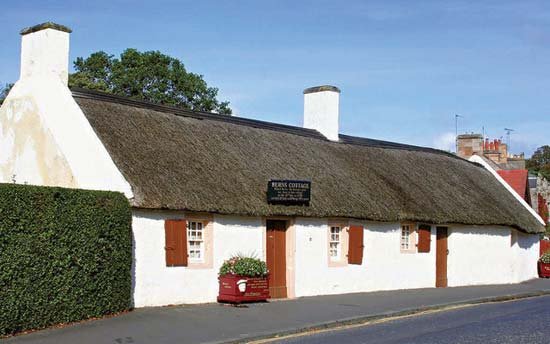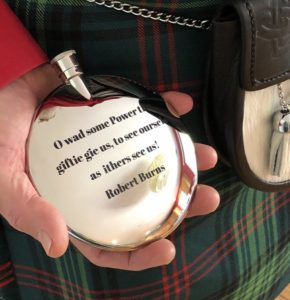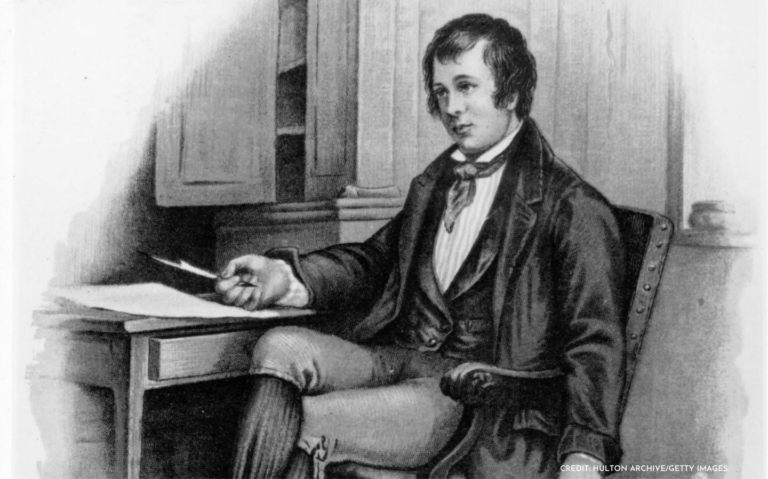I am a “newb” when it comes to Robert Burns. I went to my first Burns Night Supper a few years ago. I actually studied some of his poetry before going to the celebration because I expected to spend the entire evening talking about and listening to the poetry of Scotland’s national bard. It was, after all, an occasion to pay tribute to the beloved and prolific Scottish poet on the day of his birth, January 25. While there was poetry, it felt like more a “have to” as defined by the widely accepted structure of Burns Night than an enthusiastic celebration of the words of a man widely regarded as Scotland’s national poet and voted as “the Greatest Scot” ever in a 2009 poll.
This year because of the pandemic I won’t be disappointed by too few poetry recitations at a Burns Night celebration because I will be stuck at home. And rather than participate in one of the many virtual celebrations, I am using the bard’s birthday to dig a bit deeper into his works. As a Scottish American, I feel I have a duty to know more about Rabbie Burns than just the words to “Auld Lang Syne!”
Who he was

Robert Burns, also called the Ploughman’s Poet, was born January 25, 1759, in Alloway, Ayrshire, Scotland. He farmed for many years, as had his tenant farmer father, and then in later life became an excise officer. He published his first works, Poems, Chiefly in the Scottish Dialect, at the age of 27. He was a lover and a father with 12 to 14 children, depending on the source. While his wife, Jean Amour, bore him nine children; the others were born out of wedlock. The philandering poet is definitely an apt description!
During his brief lifetime (he died at the age of 37), he wrote more than 700 poems and songs; according to some sources the full extent of his work will probably never be known. Burns composed poetry about everyday things in his life; for example, A Poet’s Welcome to His Love Begotten Daughter was written upon the birth of his first illegitimate child; the poem expressed not only love for his new daughter but also defiance at his moralistic critics.
Because he wrote in Scots dialect about a unique Scottish identity at a time when English language and culture were becoming the accepted norm in Scotland, Burns’ poetry was widely embraced and helped spur interest in maintaining Scottish nationalism.
Learn more about his poetry
With such a wealth of work, it’s easy to be intimidated by Burns’ poetry. I recommend starting with some of his well known poems and songs, and branching out from there. These titles are commonly listed as some of his best known and loved works:
To a Mouse, On Turning Her up in Her Nest With the Plough
Surprise! A line in the poem was used by a famous author as the title for one of his books. Don’t worry; you’ll get it.
Address to a Haggis
Required recitation at Burns Night Celebration
Tam O’Shanter
The protagonist of this poem gave his name to the traditional Scottish bonnet he wore, and by which we still call it today.
A Red, Red Rose
Bob Dylan, the American folk singer, cited Robert Burns, and this poem in particular, as his greatest inspiration.
Selkirk Grace
Another standard at Burns Night
My Hearts’ in the Highlands
Isn’t this true for all Scottish Americans!!
And not to forgot Burns’ bawdier side, check out these erotic poems/songs (of which he wrote many!)
John Anderson my Jo
Comin’ Thro’ the Rye

One of my personal favorites of Robert Burns is Sweet Afton, which I first came to know as a song performed by the bluegrass group Nickel Creek.
My husband is a fan of To a Louse and had a verse engraved on his flask:
“O wad some Power the giftie gie us
To see oursels as ithers see us!”
Where to find Burns’ poetry online
Burns’ Country is one of the first websites I found for exploring his poetry. It has a fairly comprehensive list of all of his works, and they can be viewed alphabetically as well as chronologically. Be aware that the poems on the site are in the original Scots dialect, although some words have translations. You can often find English translations of Burns’ most popular poems, though they were meant to be read and understood in the Scots.
And of course, every Scottish American should own a book, or two or three, of Robert Burns poetry of which there are many compilations. Start at your local public library, and after discovering one you enjoy, purchase and add to your home library.
What’s your favorite Burns poem?
As a Robert Burns newbie, I’d love to hear about your favorite poems and songs by the Bard of Scotland. Share in the comment section below or visit the Scottish American Insider’s Facebook page and comment on the post about highlighting this blog.


